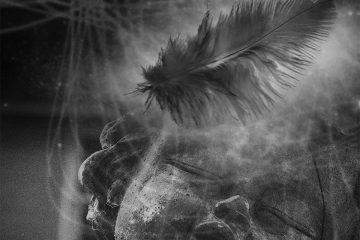Plants, Art, and Spirituality

In front of my window, as I write, I see a man hanging by ropes from a tree.
The tree is an American oak tree that I observe every day, throughout the seasons. The centuries-old oak stands in my neighbors’ garden, and I have grown very fond of it. It even came to visit me in the Amazonian forest.
The man is an acrobatic gardener. Harnessed with mountaineering ropes he climbs up, an electric saw in his hand, and starts pruning the tree’s branches. As he prunes them, leaving amputated and skeletal stumps, I suffer.
It pains me to feel helpless as I watch this cutting, which in my opinion is unnecessary and badly done, probably out of ignorance and insensitivity: removing too much material at once can actually cause the roots to die. I sympathize with the oak tree because I feel strongly that plants are also spiritual beings and not objects to be exploited for our use.
At every latitude of the world, many people like me suffer from gratuitous violence against plants, feeling that plants have also a spiritual presence.
This was further confirmed by examining the more than one hundred artistic works, from every continent, that participated in the Artistsforplants Call 2024, entitled: ‘From the background to the forefront—plants becoming protagonists.’ The Call asked artists from all over the world to put plants in the foreground, in the spotlight, to change the paradigm and (re)position them where they should be and where they belong: at center stage, with the aim of raising awareness of the fundamental role of plants and the plant world. Most of the artworks were related to spirituality as a way of connecting and communicating with our chlorophyll companions. Many artists, mostly women, have expressed the wounds they feel from the constant violations we humans inflict on nature. Through art, however, they have tried to deal with this state of affairs by finding the resilience, spirituality, and hope of plants that continue to flourish in spite of everything, as if life and relationship can find a way to sprout in any condition.
“I had the joy of admiring the exhibition in which each work reflected the connection between plants and the spiritual, an inspiring reminder of the union between nature and the human soul,” commented Naomi Ortiz, a student who participated in the final event of the Call, at the Environmental Education Centre in Otongachi (Ecuador). On 19–20 January, during the final event, a digital gallery, composed of 20 works of different genres from 17 countries, selected by the jury from more than one hundred submissions, was shown.
Among the selected artists, I was impressed by the work of Bhavi Trivedi, who was inspired by a fallen tree to create a site-specific installation in the heart of a forest in Auroville (India). 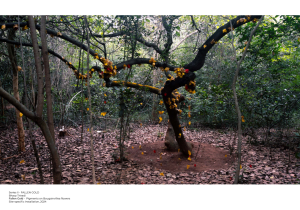 As Bhavi writes, “The copper pod tree, known in Auroville as the ‘Service tree,’ produces yellow flowers that bloom in the summer. In recent years they have been a constant source of inspiration in the heat, but have since been cut down. The street is now hot and empty, and where the trees should be blooming there is loose red soil.”
As Bhavi writes, “The copper pod tree, known in Auroville as the ‘Service tree,’ produces yellow flowers that bloom in the summer. In recent years they have been a constant source of inspiration in the heat, but have since been cut down. The street is now hot and empty, and where the trees should be blooming there is loose red soil.”
The installation is an ode to the fallen trees, and in an attempt to capture their golden fall each Bougainvillea flower was hand-painted and glued using natural and processed pigments. Nearly 800 flowers were transformed and attached to the tree over the course of three weeks “as a meditative practice to release any harbored anger and resentment towards the senseless felling of trees.” This ephemeral installation withstood sunshine and rain for two weeks before being taken down.
“Religar series”, from the “Forest Time” project by Portuguese artist Evgenia Emets, is a series of poems born from the deep listening of seven plants, in Lisbon. 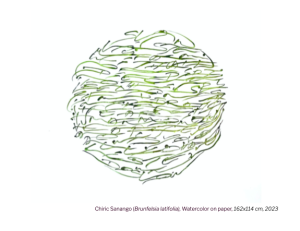 The artist retells the stories and messages of the plants through poetry, a series of calligraphy works on paper, and immersive art experiences. “My approach was to invite the plants to join a council, a circle, to speak and reveal their true name and their true purpose for being here, as well as their message to humanity. I asked them the following questions, after which some answers and guidance were given to me directly by the plants and put into poem form: What is your name? What is your journey? What is your story? What is your gift? What is your essence? What is your message?”
The artist retells the stories and messages of the plants through poetry, a series of calligraphy works on paper, and immersive art experiences. “My approach was to invite the plants to join a council, a circle, to speak and reveal their true name and their true purpose for being here, as well as their message to humanity. I asked them the following questions, after which some answers and guidance were given to me directly by the plants and put into poem form: What is your name? What is your journey? What is your story? What is your gift? What is your essence? What is your message?”
Thrity Vakil, instead, through his artwork “Chlorophyllia harmonia” explores the central role of plants in Earth’s biosphere, emphasizing their shift from background organisms to central agents in ecological balance. 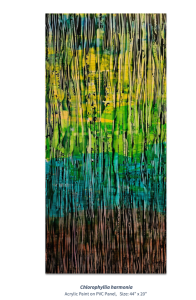 The composition, characterized by layers of greens and yellows along vertical axes, visually represents the photosynthetic processes that drive energy flow within ecosystems. The dynamic shapes symbolize the resilience and adaptability of plant species, which are essential in carbon sequestration and the stabilization of global ecosystems. By placing plants in the foreground this work invites us to rethink their ecological significance, emphasizing their role as primary producers in the planetary system.
The composition, characterized by layers of greens and yellows along vertical axes, visually represents the photosynthetic processes that drive energy flow within ecosystems. The dynamic shapes symbolize the resilience and adaptability of plant species, which are essential in carbon sequestration and the stabilization of global ecosystems. By placing plants in the foreground this work invites us to rethink their ecological significance, emphasizing their role as primary producers in the planetary system.
Canadian artist Sarah Abbott was inspired by the contemplation of plants in the creation of her video-art “Gestures toward Plant Vision.” The artist reminds us that when we consciously imagine how plants can perceive in ways similar to and different from our own, human beings move beyond anthropocentric perception and behavior to make room for empathic relationships with the aliveness of the plant world with which we share life on the planet and which, in turn, perceives human beings through their own unique, botanically embodied ways of being. “Gestures toward Plant Vision” offers a cinematic meditation on how plants might visually perceive their worlds and inspires viewers to consider other ways trees and plants, in all their varieties, might neurobiologically create images to see in stillness, motion, layers, form, color, light, shadow, and/or time.
In turn, the film’s audio invites us to consider how plants might be aware of and perceive sound in their environment, and includes a reflection on the plant vision hypothesis by Dr. Paco Calvo, a leader in the philosophy of plant neurobiology, behavior, and signaling. He talks about a controversial scientific topic: plant vision. He says that we know that leaf anatomy, in principle, has the means to use information, wavelengths, optically, and it is photosensitive. We need to think and imagine how to test the possibility of how they could have evolved vision. Instead of closing our eyes with the prejudice that they are plants and cannot see, we need to test this possibility, both in nature and in the laboratory. Once Prof. Calvo finishes speaking in the film, the artist continues with images of quiet simplicity to make room for the plants and for inspiring contemplation of other ways plants might perceive visually and sonically.
The images Italian Artist Giusi Bonomo took from the perspective of the Tree and which are part of the series “The Botany of Affections is not a secondary science,” tell us that trees have been here long before humans and will be the last to die: they manage to defy adversity, they bend to the wind, to the hand of humans, they embrace it but they do not break. “The Tree of Life, The Tree of Knowledge, The Tree Way of Life: it is always the tree that is the protagonist; all religions, all cultures, and the history of humankind from its origins are linked to the tree,” she writes.
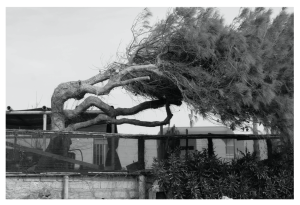 Many other works of art were exhibited that emphasized and represented the connection between plants and spirituality. In addition, the link was also emphasized by the management of the Call, which saw the collaboration between Artistsforplants and the Otonga Foundation. The Otonga Foundation purchases hectares of pristine forest to preserve its biodiversity and protect it from speculation. The Artistsforplants group, on the other hand, works inspired by the ways of plants, sharing skills and intuition in a free, cooperative, non-hierarchical, free of charge, and voluntary way.
Many other works of art were exhibited that emphasized and represented the connection between plants and spirituality. In addition, the link was also emphasized by the management of the Call, which saw the collaboration between Artistsforplants and the Otonga Foundation. The Otonga Foundation purchases hectares of pristine forest to preserve its biodiversity and protect it from speculation. The Artistsforplants group, on the other hand, works inspired by the ways of plants, sharing skills and intuition in a free, cooperative, non-hierarchical, free of charge, and voluntary way.
More and more people in many countries empathize with plants, reminding us that plants are not objects to be exploited for our use, but also spiritual beings who collaborate with us.
#
Sara Michieletto is a violinist and composer interested in the counterpoint between music and the living organisms of our planet. For many years she has played the first violins in the Orchestra “Teatro La Fenice” in Venice and has collaborated with some of the world’s most important orchestras, including the London Philharmonic Orchestra and the BBC Symphony Orchestra in Manchester. Sara is co-founder and curator, together with Silvia Chiodin, of the initiative Artistsforplants, in which international artists share their works and interpretations to remind us of the centrality of the plant world to our existence. Each year, Artistsforplants identifies a partner and a theme, and launches an international Call for artists to produce artwork to raise awareness of the chosen theme. The 2024 Call was the fifth and was developed in partnership with the Otonga Foundation.
Counterpoint blogs may be reprinted with the following acknowledgement: “This article was published by Counterpoint Navigating Knowledge on 16 April 2025.” The views and opinions expressed on this website, in its publications, and in comments made in response to the site and publications are those of the author(s) and do not necessarily reflect the views and opinions of Counterpoint: Navigating Knowledge, its founders, its staff, or any agent or institution affiliated with it, nor those of the institution(s) with which the author is affiliated. Counterpoint exists to promote vigorous debate within and across knowledge systems and therefore publishes a wide variety of views and opinions in the interests of open conversation and dialogue.
Image credits: © with the respective artists; used with permission.
